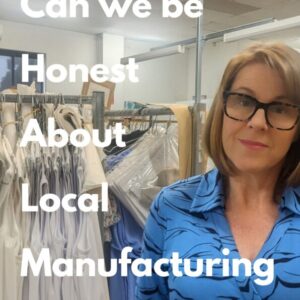Navigating the Challenges of Offshore v Local Manufacturing

Are you thinking about moving your manufacturing back locally? Let’s dive into some key challenges of Offshore v Local production and considerations you’ll face during this process.
Sourcing Fabrics and Materials: Offshore v Local Manufacturing
When you work with offshore manufacturers, they often handle everything for you. They control their timelines and deliver materials when needed. This can make the production process seem seamless and efficient.
However, with onshore manufacturing, sourcing fabrics, labels, and trims falls on you. This change can deeply affect your timeline. Without all materials in hand, your local manufacturer can’t start production. Delays in delivery can cascade, impacting your entire schedule. The shift from offshore to onshore means taking on more responsibilities but also gaining more control over the production process.
Pricing Complex Garments
When it comes to simpler products like t-shirts or jumpers, pricing can be straightforward. Local manufacturers have experience with such items and can quote prices easily. Offshore manufacturers, on the other hand, can often offer lower prices due to larger scale operations.
Unfortunately sending a tech pack will not help in many cases as this does not tell the whole story.
For complex garments, though, it’s trickier. Determining the cost requires developing a pattern, making a sample, and assessing the complexity. Changes and tweaks can throw you back into the development cycle and delay accurate production pricing. The true cost of offshore vs onshore manufacturing isn’t always evident at first glance. It’s crucial to understand that while offshore might initially seem cheaper, the hidden costs and complexities can add up.
Quantities and Their Impact: Offshore v Local Manufacturing
Supplying a single large quantity number doesn’t help much. You need to break it down by style, colour, and size. In one case, a client provided an overall number that seemed reasonable, but the breakdown revealed only a few pieces in each size and colour.
This level of detail influences cost and scheduling. For some quantities, it feels more like sampling than production, which can significantly alter costs and timelines. Offshore manufacturers often handle large bulk orders more efficiently, while onshore manufacturers might offer more flexibility for smaller, detailed runs.
Production Schedules and Realistic Expectations
Local manufacturers often book production a month in advance. Expecting them to be ready at the drop of a hat isn’t practical. It’s crucial to provide them with all materials and clear details well in advance to secure your spot. Offshore manufacturers might have shorter lead times due to their larger capacity, but this doesn’t always translate to better service.
Unrealistic expectations could be detrimental to your manufacturing relationship. If you don’t deliver then they are left in the lurch or you will be putting them under too much pressure, which in turn, pressures you to rush your preparations. Neither of these scenarios bode well for quality production or peace of mind. Understanding the differences in production schedules between offshore and onshore can help set more realistic expectations and ensure smoother operations.
Workshops and Further Learning: True Cost of Offshore v Local Manufacturing
But there is so much more to it. Understanding onshore versus offshore manufacturing is vital. Knowing the differences in costs and processes can guide your decisions effectively. For instance, I host a workshop, “The True Cost of Offshore vs Onshore,” which runs three times a year.
This free session offers valuable insights into price differences and other critical factors. It’s a must-attend for those considering the shift back to local manufacturing. Learning about the true cost of offshore vs onshore can save you from unexpected hurdles and help you make more informed decisions.
Conclusion
Transitioning from overseas to local manufacturing comes with its own set of challenges. From sourcing materials yourself to understanding the complexities of pricing and quantities, there’s a lot to navigate. Proper planning and realistic expectations are key. For those seeking further knowledge, workshops like “The True Cost of Offshore vs Onshore” can provide deep insights and aid in making informed decisions. Consider all these aspects to ensure a smooth transition and successful local manufacturing experience.
Have you been to our True Cost of Offshore v Onshore Masterclass?
Have you ever wondered what if it actually is cheaper to manufacture overseas, or are you better off with local production?
If you want to know the Facts about what it ACTUALLY costs to make your product then…..
you NEED to attend this Masterclass
- Are you unsure what to do first and how to decide on where to manufacture.
- Have you tried overseas manufacturers but the samples you got back are not right and you are wondering if you should persist.
- Have you spoken to a local manufacturer, but you feel it is too hard and you could not work out the overall cost.
- You have a business and have been producing offshore, but the costs are so unpredictable.
- Are you aware of the local desire for locally made products, but you are not sure where to start or if it is actually financially worth it.
- Are you interested in simply understanding if the rumours on costs and blowouts from offshore manufacturers are actually true.
I want you to know you have found the right place.
Over the last 30yrs I have worked in the industry, I have experience both local and offshore manufacturing and I want to show you the facts.
Sample Room has a dedicated team who understand where you are at and how to help you understand what is involved in creating products and launching your label.
Join the waitlist for the ‘True Cost of Offshore V Onshore Masterclass’ which is valued at $300, today!

